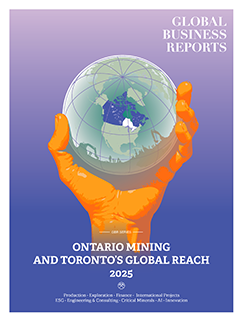
"Raising capital has become the number one concern in the sector."
RELATED PUBLICATION
ARTICLES FROM THIS PUBLICATION
Theo Yameogo
EY CANADA & EY AMERICAS MINING AND METALS LEADER, ERNST & YOUNG
How has the Canadian mining sector evolved in 2024?
The mining sector experienced significant uncertainty in 2024 due to political shifts, including the US presidential election and elections in major economies such as India, Brazil, France and the UK. This, coupled with the global nature of the commodity cycle, had a direct impact on Canadian metals and mining companies operating worldwide. However, as 2024 concludes, the environment is becoming more predictable. Looking ahead to 2025, downward trends in interest rates and increased stimulation of the OECD economies are expected to drive growth in areas for which minerals and metals are essential.
What are the key changes in EY’s 2025 ‘Top 10 risks and opportunities for mining and metals companies’ report compared to prior years?
The key change is that raising capital has become the number one concern in the sector. While it has always been a focus, it now dominates the agenda. The recent movements in the deals environment highlight the seriousness with which companies are reevaluating their portfolios. JVs, as we predicted in previous reports, are also increasing as companies look for collaborative ways to strengthen their positions.
Raising capital for certain critical minerals like lithium, graphite and nickel has become challenging due to slower-than-expected EV adoption and a drop in the prices of those commodities. Additionally, cheaper yet less environmentally friendly nickel production in Indonesia has impacted global prices. Despite these challenges, copper remains a strong performer with consistent demand and successful capital raising, while uranium is seeing a resurgence due to increased demand for nuclear reactors, boosting its stock prices and production activities.
How can Ontario’s mining sector tackle funding challenges for juniors?
The financing challenges that juniors are facing stem in part from an oversupply of projects, which dilutes focus from top-tier opportunities. While large-scale projects consistently secure funding, political barriers often hinder investment into smaller projects. Issues such as strained relations between countries and restrictive governmental systems prevent the free flow of capital, even when funds are available. Companies have recently considered relocation in order to access financing, but such decisions are temporary and unsustainable. Resolving political conflicts and improving international collaboration could help restore investment flow. Countries like India and China hold potential for significant investment growth in Canada’s mining and metals sector.
To attract retail investors and pension funds, the sector needs to address long, inefficient permitting processes and regulatory uncertainties that deter investment. One potential solution is restructuring business models so that exploration projects are tied to producing assets, enabling earlier returns. Additionally, government support, such as tax incentives and minority stakes in critical mineral projects, can build confidence. For instance, if the government were to take a 25% stake in Canadian lithium mines, it could demonstrate commitment, attract investors, and help secure off-take agreements. Such measures could potentially bolster the junior mining sector and make it more competitive.
Is cybersecurity a significant concern for Canadian mining companies?
Cybersecurity remains a significant threat to the sector, especially as companies increasingly adopt various types of technology and automation in their operations. Digitization of operations exposes companies to potential cyberattacks on automated systems such as ventilation, asset management and mine processes. These threats are not limited to ransom attacks but extend to state-sponsored actors who could compromise critical infrastructure like tailings dams, potentially causing environmental disasters and damaging the credibility of the companies. Cybersecurity is becoming an integral part of health safety, and environmental (HSE) considerations due to its potential to impact these areas directly.
As the sector advances technologically, the integration of automation, AI and remote systems heightens the need for robust cybersecurity postures. This growing reliance on digital systems will likely push cybersecurity back to the top of risk rankings.
What are your priorities for 2025?
The mining industry thrives on trust, with professionals often maintaining connections for decades; I personally still work with clients and colleagues from over 20 years ago. In 2025, our focus will be on helping clients strengthen trust in markets, people and the predictability of their performance. By staying client-focused and committed to enhancing their businesses, we deliver on our mandates to help drive their growth and success to the next level.











